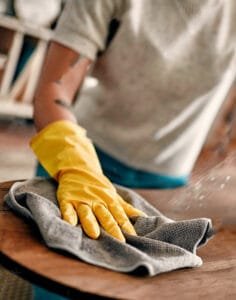Maintaining the pristine look of your hardwood floors can be challenging, especially when streaks make them look less than perfect. To help you achieve gleaming, streak-free floors, here’s a complete guide that answers your most pressing questions and provides practical solutions.
Why Do Hardwood Floors Streak?
Streaking on hardwood floors often happens due to using too much cleaner, not rinsing properly, or cleaning with a dirty mop. Water or cleaner residues left behind can cause unsightly streaks. Knowing the right methods and materials can help prevent these issues and keep your floors flawless.
Related Blog: How to Clean Newly Refinished Hardwood Floors
Essential Tools and Materials
To clean hardwood floors without leaving streaks, you’ll need:
1. Microfiber mop:
Gentle on wood and effective at picking up dirt.
2. pH-neutral hardwood floor cleaner:
Helps clean without causing damage or leaving residue.
3. Warm water:
Best for diluting cleaner and rinsing.
4. Soft cloth or towel:
Ideal for drying and buffing the surface.
Step-by-Step Guide to Streak-Free Cleaning

1. Dust and Sweep:
Start by sweeping or vacuuming the floor to remove loose debris and dust. This prevents dirt from being spread during the mopping process, ensuring a smoother clean.
2. Use the Right Cleaner:
Dilute a pH-neutral hardwood floor cleaner in water as per the manufacturer’s instructions. Using too much can result in sticky residues and streaks.
3. Dampen the Mop Lightly:
Ensure your microfiber mop is only slightly damp. An overly wet mop can leave streaks and may damage your floor over time.
4. Mop with Care:
Clean in the direction of the wood grain. This technique helps capture dirt effectively and avoids streaks.
5. Dry Immediately:
Use a soft, dry cloth or towel to wipe the floor. This step helps prevent any remaining moisture from leaving streaks or causing damage.
Related Blog: How to Clean Old Hardwood Floors
Tips for Optimal Cleaning Results
1. Avoid Harsh Chemicals:
Cleaning products with ammonia or vinegar can dull the finish of hardwood and create streaks. Always choose a cleaner that’s safe for hardwood.
2. Don’t Skip the Drying Step:
Leaving floors to air dry increases the risk of streaking. A quick dry towel makes all the difference.
3. Use Clean Equipment:
Always ensure your mop and clothes are clean. A dirty mop can spread dirt and leave marks.
4. Routine Maintenance:
Regular sweeping or dry mopping can minimize the buildup of debris, making weekly mopping more effective.
Enhancing Your Hardwood’s Longevity
Besides cleaning, regular maintenance like polishing every 2-3 months and scheduling professional deep cleaning (like those offered by Lori Maid’G) can preserve the sheen and integrity of your floors. Professional services are especially recommended if your floor’s finish starts to look dull or damaged.
Related Blog: How to Clean Engineered Hardwood Floors
Common Mistakes to Avoid
1. Using Too Much Water:
Excess moisture can seep into the seams, potentially warping the wood and leading to streaks.
2. Skipping the Rinse:
Even a small amount of cleaner left behind can cause visible streaks.
3. Not Changing Mop Pads:
A dirty pad simply redistributes dirt and grime.
FAQs
Q: Can I use a steam mop on hardwood floors?
A: It’s best to avoid steam mops. The heat and moisture can harm the wood and its finish, leading to potential damage.
Q: What’s the best way to remove stubborn marks?
A: For tough marks, lightly rub the area with a damp cloth and a few drops of hardwood-safe cleaner. Always dry the area immediately after.
Q: How often should I mop hardwood floors?
A: Weekly or bi-weekly, depending on foot traffic. More frequent dusting can reduce the need for mopping.
Conclusion
Achieving a streak-free shine on your hardwood floors doesn’t have to be complicated. By using the right tools, techniques, and products, you can maintain their natural beauty and longevity. For a deeper clean or when facing persistent challenges, consider Lori Maid’s professional cleaning services in Milwaukee for expert care and peace of mind.
Found this blog helpful? You might also be interested in following similar topics:







